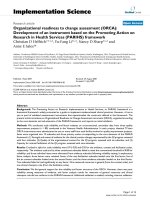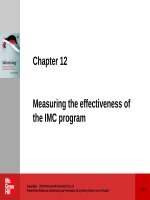Lecture Conducting and reading research in health and human performance (4/e): Chapter 14 - Ted A. Baumgartner, Larry D. Hensley
Bạn đang xem bản rút gọn của tài liệu. Xem và tải ngay bản đầy đủ của tài liệu tại đây (285.31 KB, 43 trang )
Chapter 14
Inferential Data Analysis
Inferential Statistics
Techniques that allow us to study samples and
then make generalizations about the population.
Inferential statistics are a very crucial part of
scientific research in that these techniques are
used to test hypotheses
Uses for Inferential Statistics
Statistics for determining differences between
experimental and control groups in experimental
research
Statistics used in descriptive research when
comparisons are made between different groups
These statistics enable the researcher to
evaluate the effects of an independent variable
on a dependent variable
Sampling Error
Differences between a sample statistic and a
population parameter because the sample is not
perfectly representative of the population
Hypothesis Testing
The purpose of the statistical test is to evaluate
the null hypothesis (H0) at a specified level of
significance (e.g., p < .05)
In other words, do the treatment effects differ
significantly so that these differences would be
attributable to chance occurrence less than 5 times in
100?
Hypothesis Testing Procedures
State the hypothesis (H0)
Select the probability level (alpha)
Determine the value needed for significance
Calculate the test statistic
Accept or reject H0
Statistical Significance
A statement in the research literature that the
statistical test was significant indicates that the
value of the calculated statistic warranted
rejection of the null hypothesis
For a difference question, this suggests a real
difference and not one due to sampling error
Parametric Statistics
Techniques which require basic assumptions about
the data, for example:
normality of distribution
homogeneity of variance
requirement of interval or ratio data
Most prevalent in HHP
Many statistical techniques are considered robust to
violations of the assumptions, meaning that the
outcome of the statistical test should still be
considered valid
ttests
Characteristics of t-tests
requires interval or ratio level scores
used to compare two mean scores
easy to compute
pretty good small sample statistic
Types of ttest
One-Group t-test
Independent Groups t-test
t-test between a sample and population mean
compares mean scores on two independent samples
Dependent Groups (Correlated) t-test
compares two mean scores from a repeated
measures or matched pairs design
most common situation is for comparison of pretest
with posttest scores from the same sample
Hypothesis Testing Errors
Hypothesis testing decisions are made without
direct knowledge of the true circumstance in the
population. As a result, the researcher’s
decision may or may not be correct
Type I Error
Type II Error
Type I Error
. . . is made when the researcher rejects the null
hypothesis when in fact the null hypothesis is true
probability of committing Type I error is equal to the
significance (alpha) level set by the researcher
thus, the smaller the alpha level the lower the chance
of committing a Type I error
Type II Error
. . . occurs when the researcher accepts the null
hypothesis, when in fact it should have been rejected
probability is equal to beta (B) which is influenced by
several factors
inversely related to alpha level
increasing sample size will reduce B
Statistical Power – the probability of rejecting a false
null hypothesis
Power = 1 – beta
Decreasing probability of making a Type II error
increases statistical power
Hypothesis Truth Table
NULL HYPOTHESIS
TRUE
FALSE
ACCEPT
CORRECT
DECISION
TYPE II
ERROR
REJECT
TYPE I
ERROR
CORRECT
DECISION
DECISION
ANOVA Analysis of Variance
A commonly used family of statistical tests
that may be considered a logical extension of
the t-test
requires interval or ratio level scores
used for comparing 2 or more mean scores
maintains designated alpha level as compared to
experimentwise inflation of alpha level with multiple
t-tests
may also test more than 1 independent variable as
well as interaction effect
Oneway ANOVA
Extension of independent groups t-test, but may
be used for evaluating differences among 2 or
more groups
Repeated Measures ANOVA
Extension of dependent groups t-test, where
each subject is measured on 2 or more
occasions
a.k.a “within subjects design”
Test of sphericity assumption is recommended
Random Blocks ANOVA
This is an extension of the matched pairs t-test
when there are three or more groups or the
same as the matched pairs t-test when there are
two groups
Participants similar in terms of a variable are
placed together in a block and then randomly
assigned to treatment groups
Factorial ANOVA
This is an extension of the one-way ANOVA for
testing the effects of 2 or more independent
variables as well as interaction effects
Two-way ANOVA (e.g., 3 X 2 ANOVA)
Three-way ANOVA (e.g., 3 X 3 X 2 ANOVA)
Assumptions of Statistical Tests
Parametric tests are based on a variety of
assumptions, such as
Interval or ratio level scores
Random sampling of participants
Scores are normally distributed
N = 30 considered minimum by some
Homogeneity of variance
Groups are independent of each other
Others
Researchers should try to satisfy assumptions
underlying the statistical test being used
Improving the Probability of Meeting
Assumptions
Utilize a sample that is truly representative of
the population of interest
Utilize large sample sizes
Utilize comparison groups that have about the
same number of participants
TwoGroup Comparison Tests
a.k.a. Multiple Comparison or Post Hoc Tests
The various ANOVA tests are often referred
to as “omnibus” tests because they are used
to determine if the means are different but
they do not specify the location of the
difference
if the null hypothesis is rejected, meaning that
there is a difference among the mean scores, then
the researcher needs to perform additional tests in
order to determine which means (groups) are
actually different
Common Post Hoc Tests
Multiple comparison (post hoc) tests are used to
make specific comparisons following a
significant finding from ANOVA in order to
determine the location of the difference
Duncan
Tukey
Bonferroni
Scheffe
Note that post hoc tests are only necessary if there are
more than two levels of the independent variable
Analysis of Covariance
ANOVA
ANOVA design which statistically adjusts the
difference among group means to allow for the
fact that the groups differ on some other
variable
frequently used to adjust for inequality of groups at
the start of a research study
Nonparametric Statistics
Considered assumption free statistics
Appropriate for nominal and ordinal data or in
situations where very small sample sizes (n < 10)
would probably not yield a normal distribution of
scores
Less statistical power than parametric statistics









